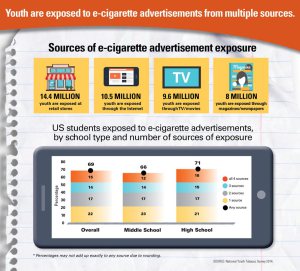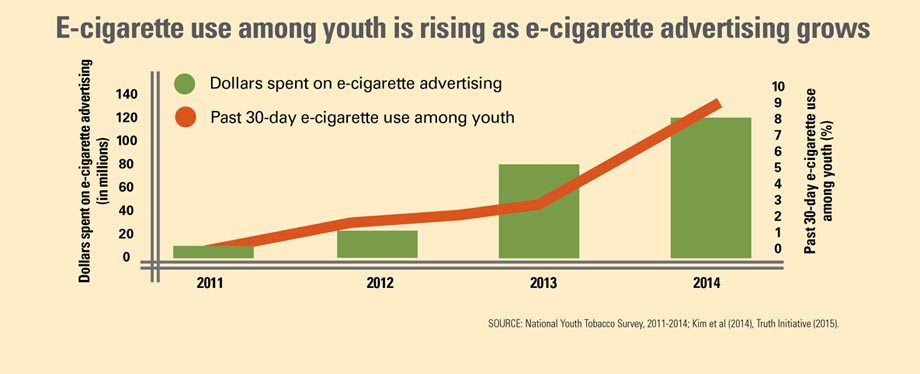Report Finds That As E-Cigarette Ad Spending Increases So Does Teens’ Use Of The Devices
About 2.4 million teens smoked e-cigarettes last year, and that number is poised to rise, thanks in part to the tens of millions of dollars device manufactures have poured into advertisements for the products, according to a new report from the Centers for Disease Control and Prevention.
The agency’s Vital Signs report found that more than 18 million young people see e-cigarette advertising in stores, online, in newspapers and magazines, or on television and in movies, increasing the likelihood they’ll eventually pick up one of the devices.
In fact, the report, which is based on a 2014 survey of 22,000 children and teens, found a correlation between increased ad spending and the number of teens who are using e-cigarettes.
The industry has rapidly increased marketing spending from $6.4 million in 2011 to $115 million in 2014, according to the CDC report.
During that same time period, e-cigarette use in the past 30 days increased from less than 1% to almost 4% among middle school students and from less than 2% to 13% among high school students.
“Exposure to e-cigarette advertisements may be contributing to increases in e-cigarette use among youth,” the CDC hypothesizes.
According to the CDC, the continued uptick in advertising of e-cigarettes threatens to undo decades of campaigns that focused on keeping teens away from tobacco products.
That’s because e-cigarette ads use many of the same themes – independence, rebellion, and sex – used to sell cigarettes and other conventional tobacco products.

Teens says they see nearly the same amount of ads on TV, online, in stores and in magazines or newspapers. {click to enlarge}
“The same advertising tactics the tobacco industry used years ago to get kids addicted to nicotine are now being used to entice a new generation of young people to use e-cigarettes,” CDC Director Tom Frieden, said in a statement. “Kids should not be using e-cigarettes and yet two-thirds of kids in this country are seeing e-cigarette ads.”
In all, the CDC report found that 68.9% of middle and high school students see ads from one or more media sources.
Most see e-cigarette ads in retail stores – about 54.8% – while about 39.8% view ads online. Similarly, nearly 36.5% of teens see the products on TV or in movies, and 30.4% reported viewing ads in newspapers and magazines in the last year.
The CDC and health advocates warn that if advertising, and other aspects of the e-cigarette industry aren’t regulated soon, more and more young people will be drawn to the devices.
“The irresponsible and indiscriminate marketing by the e-cigarette industry, coupled with a complete lack of government oversight, is putting the health of our nation’s kids at risk,” Matthew Myers, president of the Campaign for Tobacco-Free Kids, tells NBC News. “It shouldn’t be a surprise that youth use of e-cigarettes has skyrocketed when kids are being inundated with marketing for these products.”
E-cigarettes have become increasingly popular in recent years, while the Food & Drug Administration has been slow to implement federal regulations.
While we wait for a final verdict on the FDA’s proposed regulations over e-cigarettes, the CDC suggests states and communities can do more to protect their youngest residents from the devices and the advertisements that go along with them. Those strategies include:
• Limiting tobacco product sales to facilities that never admit youth,
• Restricting the number of stores that sell tobacco and how close they can be to schools,
• Requiring that e-cigarettes be sold only through face-to-face transactions, not on the Internet, and
• Requiring age verification to enter e-cigarette vendor’s websites, make purchases, and accept deliveries of e-cigarettes.
“States and communities can also help reduce youth tobacco use by funding tobacco prevention and control programs that address the diversity of tobacco products available on the market, including e-cigarettes,” Corinne Graffunder, director of CDC’s Office on Smoking and Health, said in a statement. “We know what works to effectively reduce youth tobacco use. If we were to fully invest in these proven strategies, we could significantly reduce the staggering toll that tobacco takes on our families and communities.”
Want more consumer news? Visit our parent organization, Consumer Reports, for the latest on scams, recalls, and other consumer issues.


